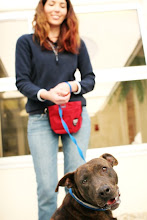This will take time! So be ready to invest in it. There is nothing worse than being drug around like a rag doll every time you take Fido for his evening walk. It's tiresome, painful and let's face it, a little embarrassing. Unfortunately, for many dogs, the solution equals no more walks.
This is just not fair, nor is it healthy for either human or K9. So let's tackle this problem head on.
First off, make sure you have the correct equipment. A 4-6 foot nylon lead and simple nylon buckle or snap collar. NO PINCH COLLARS OR CHOKER CHAINS! The only other acceptable apparatus would be a Gentle Leader Easy Harness. This is NOT a typical harness with the hook on the back that actually encourages pulling, but instead one that goes around the dogs' front legs and has a sliding ring at the chest. This will help greatly for 'problem pullers'.
The ultimate goal of wait/heel is for the dog to walk at your pace, and stop when you do. A properly executed heel places the dog on your left side. Use the dogs name plus the command to begin; "Fluffy, Wait."
If the dog runs ahead and pulls at the lead, stop walking and repeat the command. As soon as the leash becomes slack, take another step. Repeat. Yes it is certainly possible that you will only get to take one step at a time, but keep at it. Before you know it you will be on to two, then three and so on. Eventually the dog will learn that pulling gets them nowhere fast.
(Cheat sheet: Carry tasty treats in your pocket and offer them to your dog when they walk beside you. This will help encourage them to stay close!)
After you and your dog master this, adding in the automatic sit will seem like a day at the park! The goal here is to have your dog sit every time you come to a stop. This behavior comes from simple repetition. Walk stop sit walk stop sit etc... you'll be surprised at how fast your dog learns this especially when a food reward is offered for the sit part!
If you've made it this far, congratulations! You have a very well behaved pooch! However, people never seem fully amused or satisfied with this and insist that the dog learn other people pleasing behaviors such as "gimme 5" Roll over or crawl....so here we go!
 "Gimme 5", "Shake" or "paw" is probably the number one favorite trick that people teach their dogs. It has come to a point where it seems almost as expected of them as sit! Despite being immensely popular and easy to train there are some very important rules that go along with teaching this trick to your dog.
"Gimme 5", "Shake" or "paw" is probably the number one favorite trick that people teach their dogs. It has come to a point where it seems almost as expected of them as sit! Despite being immensely popular and easy to train there are some very important rules that go along with teaching this trick to your dog.Your dog MUST learn sit, down and stay BEFORE beginning this trick! This is more important than is sounds. Just ask anyone who taught sit, then shake and then attempted down. You've just made a lot more work for yourself trust me! Besides that, down is a submissive behavior and shake a more dominant one. You should always teach the submissive behaviors first.
To train your dog to offer up their paw, place them in a sit position and take one of their front paws in your had and say "gimme 5!" (Or shake or paw) Then "Good!" and give them a tasty treat. Repeat. eventually your dog will offer their paw in exchange for a treat, or a pat on the head.
Once your dog learns this it is important to vary their routine! Don't get caught in a rut. (Sit paw down, sit paw down...) as your dog will go on auto pilot. Keep them thinking by varying their behaviors. Also important is to never reward a paw you didn't ask for!
"Crawl" is another easy one. Have your dog lie down, then hold a treat on the ground just out of their reach. Say Craaaaawl......! Your dog will most likely scoot their body on the floor to get the treat. Repeat, gradually increasing the distance you ask them to crawl.
Roll over is another immensely popular trick, but it's not the easiest, nor is it for every dog. Take into consideration your dogs shape, age and size. For example, Dachshunds should never learn this behavior as they have very fragile backs. It may be hazardous for an older or large dog as well. If your dog is young, healthy and strong enough to attempt this, then you may proceed.
Place your dog in a down position and lead their head over their shoulder with a treat. (Most dogs will 'pick a side' when lying down, so make sure to go with that and not fight it.) At first you may only succeed in getting them on their sides, but with enough work and patience, you will soon get them on their backs and then the rest of the way over.
Please note that this is an incredibly submissive behavior and extremely shy or nervous dogs may refuse to preform it. That's OK, don't force them.
Join me next time when we cover corrections, modifications, releases and praise!





No comments:
Post a Comment